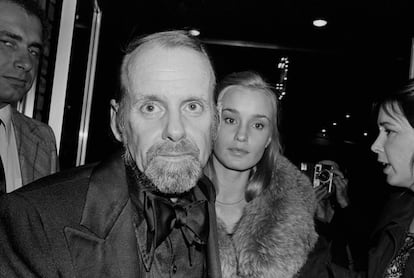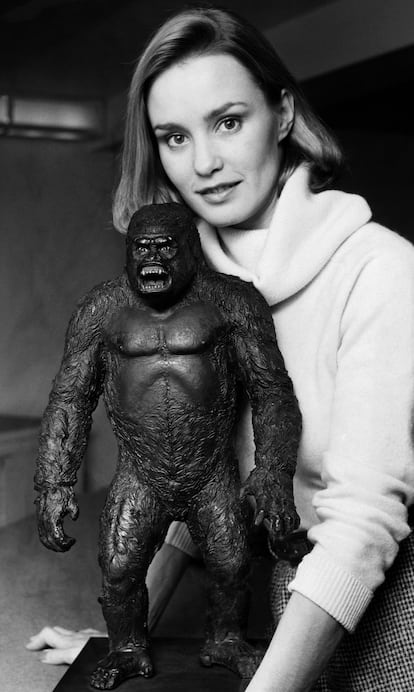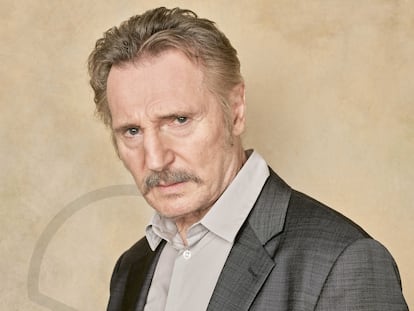Jessica Lange, the rebel icon who is threatening to retire: ‘I refuse to be an advertisement for anyone’
The winner of two Oscars, Lange sees the awards environment as corrupted. An iconic actress — who gained new recognition late in her career by starring in ‘American Horror Story’ — she has often expressed her frustrations with an industry in which sexist and ageist prejudices persist

“About three weeks before I start every job I take, I call my agent and say, ‘I don’t think I can do it. I don’t think I’m the right person. They should call Jessica Lange.’” Not even a compliment from the most prestigious of critics could come close to this comment, which was made by Meryl Streep, one of the greatest actresses of all time. She’s also been Lange’s rival: they’ve competed for several of the most succulent roles of recent decades.
But after a career that has lasted half-a-century — a career that includes two Oscars, five Golden Globes, three Emmys, a Screen Actors Guild Award and a Tony — Jessica Lange, 74, is threatening to retire. “I don’t think I’ll be doing this much longer,” the Minnesotan actress told The Telegraph a few days ago. “Creativity is now secondary to profits. There’s no emphasis on the art, the artist or the narrative. It’s just about satisfying shareholders.”
The daughter of a traveling salesman and a housewife who lived semi-nomadically, Lange got to Hollywood by chance. She wanted to sign up for painting classes after finishing her studies, but due to a lack of spots, she ended up enrolling in photography. She fell in love with her Spanish teacher, Paco Grande. With him, she toured Spain. “We went from Ronda to Asturias, stopping in many places that I would like to return to,” she told EL PAÍS in 2015.
“Paco and I lived on the road. In the United States, our house was a van. It was a very full and happy life.” That bohemian life took them to the effervescent Paris of the late-1960s, where they shared flats with photographer Robert Frank and director Larry Clark. In the French capital, she studied mime with Étienne Decroux and joined the Opéra-Comique as a dancer. Her beauty caught the attention of fashion illustrator Antonio López — the man who discovered Grace Jones and Jerry Hall. This led her to work for the Wilhelmina modeling agency, the most prestigious of the time.


At that time, the production team for the remake of King Kong (1976) was in the works, financed by tycoon Dino de Laurentiis. He was desperately looking for a sexy, fresh face. When the team saw a photo of Lange, they called her immediately. “It happened overnight. They called me in the evening and asked if I could fly to Los Angeles in the morning [for the casting]. I said yes. I had never been there before.”
King Kong was a baptism of fire in the industry. There were several technical difficulties, while De Laurentiis rushed to release what was supposed to be his biggest production. The primate’s gigantic hydraulic hand — in which Lange spent much of the shoot — played tricks on her, as she told critic Roger Ebert: “Once it had to crush me… and it almost did. [The hand] had to slap me on the head again and it almost knocked me out.”
Critics destroyed the film, but saved Lange. Pauline Kael compared her to Carole Lombard from My Man Godfrey (1936) and didn’t skimp on praising the actress throughout her career. “She has a facial structure that the camera loves… as well as talent,” she once wrote. However, the success of King Kong at the box office and the praise for her work didn’t immediately result in a flood of calls. Lange spent three years away from the spotlight, until her friend and former lover, Bob Fosse — a director and choreographer — offered her the role of the Angel of Death in All That Jazz (1979). Suddenly, she was back on the map… and this time, in a production worthy of a talent that was beginning to be obvious to everyone.
Director Bob Rafelson subsequently offered her to star alongside Jack Nicholson in another version of a classic, The Postman Always Rings Twice (1981). The result was inferior to that of the original, but it left behind the memory of the sex scene between the two main characters on a kitchen table, one of the most sensual sequences in the history of cinema. Lange and Nicholson gave a new meaning to sharing household chores, although Lana Turner — the original protagonist of James M. Cain’s work — called the film “pornographic.”


Lange’s work so impressed Graeme Clifford — the film’s editor — that he asked her to play the lead role in his directorial debut, Frances, the biography of actress Frances Farmer (a classic Hollywood figure who ended her days in and out of mental institutions). The intensity of that performance left her exhausted, but it was key in her life. While filming, she fell in love with her co-star, Sam Shepard. The two stars began a relationship that delighted the tabloid press, for whom the couple was a kind of modern version of Marilyn Monroe and Arthur Miller. He was a handsome playwright with the air of a taciturn cowboy — the prototype of an American man — while she was a prodigious and physically explosive actress. The myth was fueled by the fact that they both lived on a ranch on the edge of the world: they were beautiful, free and wild.
The good story wasn’t tarnished by the fact that the two already had partners when they began their affair. Shepard was married to the actress O-Lan Jones, with whom he had a son, while Lange — who was divorcing Paco Grande — had just given birth to a daughter with the dancer and actor Mijaíl Barýshnikov (who had, incidentally, been unfaithful to Lange with a fellow dancer). “When we started [going out], it wasn’t with the intention of moving in together, starting a family, doing all those normal things. It was just an incredibly passionate love story,” she revealed to Vanity Fair in 1991.
They were together for three decades and had two children. Shepard also encouraged her to delve deeper into her old passion for photography. He gave her a Leica M6 that he had bought in Germany. What began as fun would eventually lead to a notable career as a photographer, with exhibitions all over the world.

During the filming of Frances, there was another momentous occurrence. Kim Stanley — the actress who played Lange’s mother — suggested that, after the acting effort that had devastated her, she should try “something light.” The production with greater levity ended up being Tootsie (1982), Sydney Pollack’s comedy starring Dustin Hoffman. In it, Lange played the luminous reverse of Francis Farmer: a sweet and naive actress. And, that year, she achieved a milestone: being nominated for an Academy Award in both the main and supporting actress categories. She won in the latter category. However, nowadays, she’s not very excited by awards.
“The Oscars have become nonsense, they have nothing to do with movies. Before, it was very different. You managed as best you could. Sometimes, they would call you and offer you a dress — and, to be able to skip shopping, it seemed like a good idea. But, in the last ten years, [the Academy Awards] have reached delirious extremes,” she vented to EL PAÍS. “What’s the point of wearing jewelry that isn’t yours, [jewelry that] — since it’s worth millions — forces you to spend the night attached to a guard? I find it ridiculous and indecent. I refuse to be an advertisement for anyone, which is what it’s all about now.”
Despite this, for many years, she accumulated all kinds of awards, thanks to a glorious streak that continued, with titles such as Sweet Dreams (1985), a biopic about country singer Patsy Cline — a role that Meryl Streep unsuccessfully begged director Karel Reisz for. This was followed by Crimes of the Heart (1986) — in which she starred alongside Diane Keaton and Sissy Spacek — and the exceptional Music Box (1989), directed by Costa-Gavras, in which she plays a lawyer who discovers that her father is a war criminal. If something has defined Lange’s career, it’s her love for complex characters, who are always on the verge of breaking.

At the beginning of the 1990s, Lange — adored by the critics and queen of the 1980s box office — took a brief break to focus on her family. Afterward, she reappeared in a big way, winning an Oscar for her role as the manic-depressive wife of a military man in Blue Sky (1994). However, once she was over 40, she began to feel the first effects of a common problem faced by female actresses: ageism.
“Age discrimination is omnipresent in this sector. There’s no level playing field,” she lamented, in an interview with the AARP in 2017. “It’s not common to see 60-year-old women in romantic roles, but [it’s very common to see] 60-year-old men in romantic roles with co-stars who are decades younger.” In fact, in 1995, Lange played Liam Neeson’s wife in Rob Roy, and last year, in Marlowe, she played the mother of Neeson’s romantic interest: Diane Kruger, who is 26 years younger than the Irish actor. “[The notion that] men continue to be fascinating, attractive and virile, while women age and are no longer sexual or beautiful… it’s a fantasy that has nothing to do with reality,” she criticized in The Wrap. Unfortunately, in the Hollywood ecosystem, this farce is perpetuated.
Theater and television can often act as a refuge for actresses who, like Lange, want to continue working without being reduced to anecdotal roles. For this reason, it has been onstage and on the small screen where Lange has achieved her greatest successes in recent years, with productions such as Gray Gardens (2009), the HBO miniseries in which she and Drew Barrymore play the very peculiar aunt and cousin of Jackie Kennedy.

But Lange could hardly have imagined then that she would end up becoming one of the most recognizable and admired faces for an entirely new generation of viewers. It happened thanks to American Horror Story (2011-present), by Ryan Murphy and Brad Falchuk. This brought on a new level of fame and a new working method. “It’s interesting. Cinema is an exercise in acting where you have a first, second and third act. [But there] are times here that I don’t see the script until the day before filming the show. It’s also liberating, because Ryan writes those little arias for me, which has made our relationship into something unique,” she declared, in another interview with EL PAÍS.
Both her long-time followers and those who discovered her thanks to the horror saga love her work. Lange’s performances of David Bowie’s Life on Mars and Lana Del Rey’s Gods & Monsters on Freak Show (season four, 2014) broke the top 50 on iTunes. And her love affair with Murphy continued in FEUD: Bette and Joan (2017), where they recreated (alongside Susan Sarandon) the complex filming of What Ever Happened to Baby Jane? (1962) and the deep enmity between its protagonists: Joan Crawford (Lange) and Bette Davis (Sarandon).
Perhaps her career will be prolonged. While Lange has announced her intention to retire, her threat loses credibility when you realize that she said the same thing back in 2013. She also has several pending works, including a film about Marlene Dietrich’s years as a singer in Las Vegas (produced by Murphy) and a television adaptation of Long Day’s Journey into Night (1956), by playwright Eugene O’Neill, one of the greatest successes in theater. This guarantees that we’ll still be able to enjoy her talents again… something that, at least, we viewers will appreciate, even if she’s not considered essential. “I’m sure they won’t miss me at all,” she notes. It’s just an opinion.
Sign up for our weekly newsletter to get more English-language news coverage from EL PAÍS USA Edition
Tu suscripción se está usando en otro dispositivo
¿Quieres añadir otro usuario a tu suscripción?
Si continúas leyendo en este dispositivo, no se podrá leer en el otro.
FlechaTu suscripción se está usando en otro dispositivo y solo puedes acceder a EL PAÍS desde un dispositivo a la vez.
Si quieres compartir tu cuenta, cambia tu suscripción a la modalidad Premium, así podrás añadir otro usuario. Cada uno accederá con su propia cuenta de email, lo que os permitirá personalizar vuestra experiencia en EL PAÍS.
¿Tienes una suscripción de empresa? Accede aquí para contratar más cuentas.
En el caso de no saber quién está usando tu cuenta, te recomendamos cambiar tu contraseña aquí.
Si decides continuar compartiendo tu cuenta, este mensaje se mostrará en tu dispositivo y en el de la otra persona que está usando tu cuenta de forma indefinida, afectando a tu experiencia de lectura. Puedes consultar aquí los términos y condiciones de la suscripción digital.
More information
Archived In
Últimas noticias
Most viewed
- Oona Chaplin: ‘I told James Cameron that I was living in a treehouse and starting a permaculture project with a friend’
- Sinaloa Cartel war is taking its toll on Los Chapitos
- Reinhard Genzel, Nobel laureate in physics: ‘One-minute videos will never give you the truth’
- Why the price of coffee has skyrocketed: from Brazilian plantations to specialty coffee houses
- Silver prices are going crazy: This is what’s fueling the rally











































